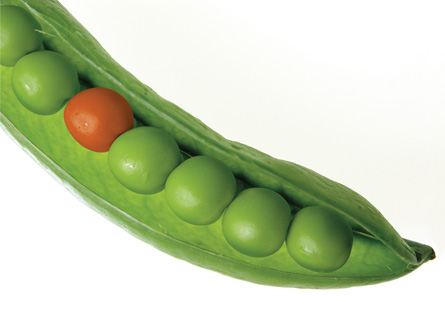Module 6
1. Module 6
1.34. Page 3
Module 6—Mendelian Genetics: The Transmission of Traits to the Next Generation
 Reflect and Connect
Reflect and Connect
The incredible effect of temperature on the gender of gecko hatchlings is experimental evidence that genes are affected by the environment. As you answer the following questions, reflect on the effect of the environment on genes and connect your understanding to developing your solutions.
 Self-Check
Self-Check
Use the following information to answer SC 1.
Sickle cell anemia is an autosomal recessive genetic disorder. Because individuals affected by sickle cell anemia have defective hemoglobin proteins, their blood cannot transport oxygen properly. There appears to be a relationship between the incidence of malaria and sickle cell anemia. Individuals with sickle cell anemia and carriers of the sickle cell allele have some resistance to malaria. Malaria is caused by the parasite Plasmodium and is transmitted between humans by mosquitoes.
autosomal recessive: a condition caused by a gene found on an autosome (non-sex chromosome), which only occurs in those with the homozygous recessive genotype
malaria: a disease of warm, wet areas caused by the plasmodiumprotist found in the Anopheles mosquito
When the mosquito bites a person, the plasmodium enters the blood stream and lays its eggs in red blood cells. Sickled red blood cells typical of those people with sickle cell anemia (SCA) are harder for the plasmodium to attack, so those with SCA are less likely to die of malaria. The homozygous recessive condition (ss) confers a disadvantage (SCA) and an advantage (protection from malaria).
SC 1. If scientists are successful in significantly reducing or eliminating malaria, the best prediction for what will happen to the allele for sickle cell anemia in the population is that it will
- not be affected by the elimination of malaria
- increase as its selective advantage is increased
- be reduced as its selective advantage is decreased
- quickly disappear as its selective advantage is increased
Use the following information to answer SC 2.
Melanin pigments range in colour from yellow to reddish-brown to black. The amount and the colour of melanin in the skin account for differences in human skin coloration.
Albinism is a genetic disorder that results in unpigmented skin and other tissues. About 1 in 20 000 humans has albinism. In humans, albinism can be caused by an autosomal recessive allele (a). Its dominant allele (A) results in normal pigmentation.
SC 2. The fact that exposure to sunlight increases melanin production in many humans and produces a tan demonstrates that
- some people have mutations that prevent melanin production
- the expression of some genes is influenced by the environment
- the environment causes mutations that increase the chance of survival
- the environment causes mutations that have no effect on the chance of survival
Use the following information to answer SC 3.
Sickle cell anemia is caused by the sickle cell allele (HbS) of a gene that contributes to hemoglobin (Hb) production. The abnormal hemoglobin (hemoglobin-S) produced causes red blood cells to become deformed and block capillaries, and there is resultant tissue damage. Affected individuals homozygous for the sickle cell gene rarely survive to reproductive age. Heterozygous individuals produce both normal hemoglobin and a small percentage of hemoglobin-S. These individuals are more resistant to malaria than individuals who are homozygous for the allele for normal hemoglobin (HbA). Their red blood cells are prone to sickling when there is a deficiency of oxygen.
SC 3. Which of the following conclusions can be drawn from all of the information provided on sickle cell anemia?
- The sickle cell gene will eventually disappear because of its interaction with malaria.
- Malaria causes heterozygous individuals to be less fertile than homozygous individuals.
- In Africa, sickle cell anemia will disappear since it is lethal in the homozygous condition.
- In Africa, carriers for sickle cell anemia have an advantage over homozygous individuals.
 Self-Check Answers
Self-Check Answers
SC 1. C
SC 2. B
SC 3. D
 Discuss
Discuss

© Photoroller/shutterstock
Consider the nature verses nurture debate. When you consider who you are, from your personality to the unique shape of your nose, what do you think has had the greatest influence in the making of who you are? Was it the random assortment of genes that you received at fertilization of your father’s and mother’s gametes? Has it been your environment and your upbringing that have allowed you to be taller, smarter, or funnier than those around you? Considering the variety of traits, such as height and behaviour, which do you believe is the definitive influence: genetics or environment?
Research this issue. Write a summary of your position and discuss your position with your peers and teacher in the class discussion area. Engage your peers in the defense of your position, and challenge others on their positions.
Discussion Rubric
Learning Outcome |
Exemplary (all points) 3 marks |
Accomplished (most of the points) 2 marks |
Developing (minimal points) 1 mark |
Not yet started 0 marks |
Communicates Ideas |
The learner communicates ideas eloquently and thoroughly. |
The learner communicates ideas, opinions, and conclusions clearly and completely. |
The learner communicates ideas well, but fails to provide evidence to support his or her ideas, opinions, and conclusions. |
The learner fails to communicate his or her ideas. |
Understanding of the Activity |
The learner’s contribution to the discussion board demonstrates a thorough understanding of the concept being presented, be it stem cell research, reproductive technology, drug use, or the environment. |
The learner’s contribution to the discussion board demonstrates an understanding of the concept being presented. |
The learner’s contribution to the discussion board demonstrates a developing understanding, but further explanation and exploration is needed. |
The learner’s contribution does not demonstrate an understanding of the task |
Peer Review |
The learner provides meaningful feedback on others’ ideas. |
The learner provides meaningful feedback on others’ ideas. |
The learner provides comments on others’ ideas, but not specific feedback. The learner’s response discourages other group members to share ideas. |
The learner does not comment on other posts. |
Mechanics of Messages |
The learner’s response has an obvious logical and/or sequential organization. |
The learner’s response has an obvious logical and/or sequential organization. |
The learner’s response lacks organization. |
The learner’s response cannot be followed or understood. |

© Steven Coling/shutterstock
 Reflect on the Big Picture
Reflect on the Big Picture
Throughout this module, you have discovered many reasons for the variation that you see in organisms. You have come to understand how members of your family can either look alike or be very different in appearance. Gene expression is also affected by the environment.
Inheritance patterns can be clearly followed and predicted up until the influence of the environment takes effect. The effect of the environment on our genes adds a level of complexity to the understanding of inheritance. Many genes might be present in individuals, but without the proper environmental exposure, they may never be expressed. As a result, the inheritance of traits may always happen according to the principles you’ve learned, but the expression of those traits may not always occur as predicted. Even with current knowledge of genetics, life can be surprising, as you discovered in the lab.
 Module 6: Lesson 7 Assignment
Module 6: Lesson 7 Assignment
Submit your completed Module 6: Lesson 7 Assignment to your teacher for assessment.